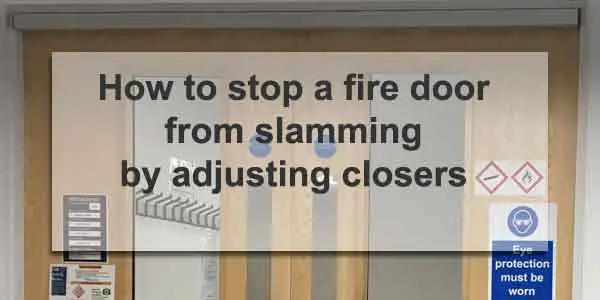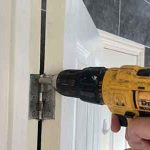Slamming fire doors can be very annoying. The good news, is you can stop your fire doors from slamming quite easily. This is done by adjusting the closing and latching speed on the door closer.
Depending on the type of closer, this is usually quite simple to do.
Fire doors are a legal requirement in certain situations. This includes commercial premises, residential flats, and HMO’s (houses of multiple occupancy). The reason fire doors are used, is to contain fire in the room where it starts.

Generally, a fire door will be able to resist fire for between 30-60 minutes. This will give people inside the building more time to escape, as the doors protect corridors and stairwells from fire. This also helps fire fighters, as the doors will contain the fire and make access to the building easier.
When a fire door is installed, it must meet several other regulations in order to be fully compliant. Some of the main regulations include:
- Fire door signs fitted to both sides of the door.
- Each door should be fitted with 3 fire rated hinges.
- The door casing should have the same rating as the fire door.
- Intumescent strips should be added to the doors along all sides.
- A door closer should be fitted on all fire doors.
One common complaint with fire doors, is they often slam shut. This can be quite annoying, and in theory it could also be damaging the fire protection the door provides.
The door, the casing, and the surrounding plaster will have the same fire rating. This means a 30-minute door, will be fitted in a 30-minute casing, and surrounded by plasterboard that gives 30 minutes protection.
Constant slamming could reduce the 30-minute rating due to minor damage.
Different fire door closers and how to stop them slamming
As we have already mentioned, when a fire door is constantly slamming, not only is it annoying, but it could also be causing damage. This could affect the door, the door frame, ironmongery, architrave, and skirting, as well as the surrounding plaster and decoration.
The good news, is this can usually be resolved, by making some adjustments to the closer.
All fire doors are fitted with some kind of closer as a legal requirement. The regulations state that the door should self-close. This requires the door to close fully into the rebate within 25 seconds.
To achieve this, a door closer is used. The most common types of closers are:
- Surface mounted closers – These are the most common and you will see them at the top of most fire doors.
- Concealed door closers – Unlike the surface mounted closers, these are more discreet and are hidden. These are usually used in order to maintain the aesthetic of the door. One of the most common types is a perko door closer.
Both types of closer will allow you to adjust the closing speed.
Adjust surface mounted closer to stop door slamming
There are various different models and styles when it comes to surface mounted closers. However, most can be adjusted in a very similar way.
In some cases, the closer may have a cover on it. If it does have a cover, this is usually clipped in place, or it is secured with a couple of screws. Either way, it should be easy to remove.
There are also models that don’t have a separate cover, and if this is the case, then it saves you a job.
Once exposed, you need to look at the end of the self-mounted closer. Here you will find 2 adjustment screws. Again depending on the type of closer, these could be either a screwdriver, or an Allen key.
One will control door closing speed and the other will control the latching speed. Generally these will be numbered or lettered to distinguish from one another (1 and 2 for example).
The adjustment that controls latching, controls the last part of the door closing. This is the adjustment that will stop your door from slamming.
The latching accounts for perhaps the last 10-20% of the door shutting. You should try to adjust this to a level where it closes gently, but still fully latches into the door frame. Following this, you can adjust the door closing speed, to achieve a smooth transition between closing and latching.
The most important thing, is to ensure the door still closes at a reasonable speed, and that it latches correctly.
Adjust perko closer to stop fire doors slamming
Adjusting a perko door closer is slightly more complicated. This is a type of concealed door closer, that can be found on the hinge side of the door. It consists of a small chain connecting the door to the casing.
Inside the door, there is a cylinder with a spring mechanism that closes the door.
To adjust the latching speed, you may need to remove the entire perko closer and adjust the closing speed at the back of the cylinder.
However, this is easier said than done. The spring is extremely powerful and requires locking in place with a small retaining plate. These retaining plates come with the closer, and without it, you will definitely struggle to replace the closer once removed.
If you are adjusting multiple doors, you have two choices:
- Buy a new closer, just for the plate.
Or - What I personally like to do, is use a small nail and slide it into the chain links to hold it in place.
Note: some better-quality closers will also have adjustment screw for closing speed, often this can be accessed without removing the closer.
See the video below for how to make this type of adjustment.




